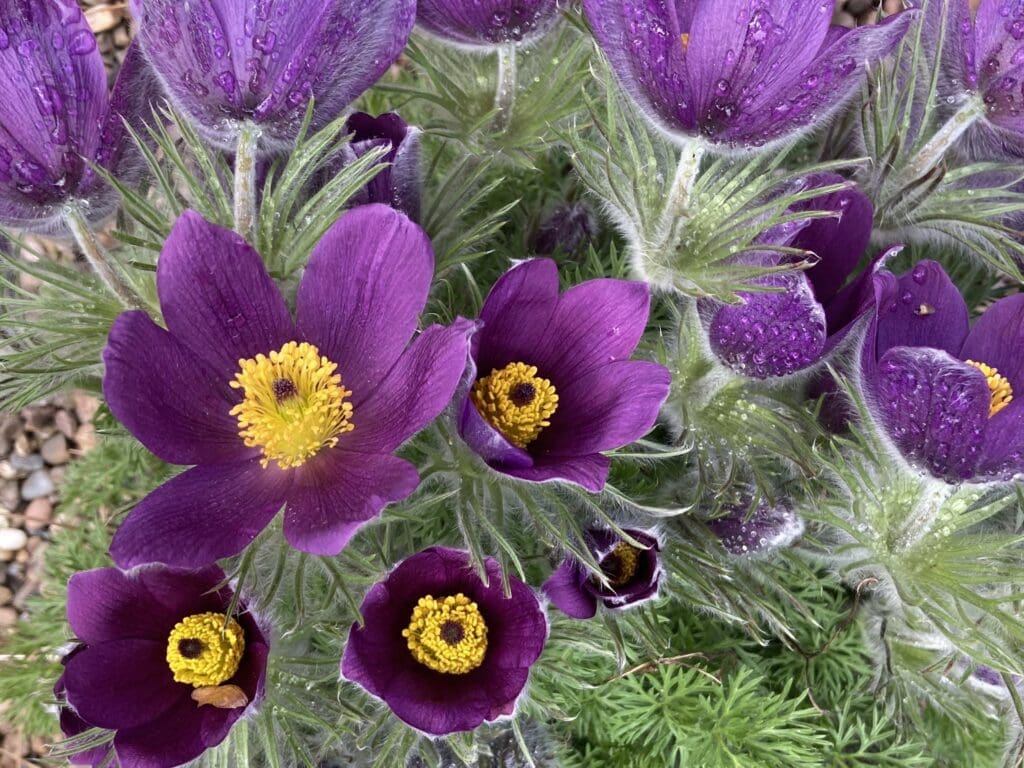
Pulsatilla nigricans
Latin name: Pulsatilla nigricans (syn. Anemone pratensis)
Short name: Puls
Common name: Wind Flower | Meadow Anemone | Pasque Flower | Easter Flower | Pulsatilla
Primary miasm: Psoric Secondary miasm(s): Sycotic
Kingdom: Plants
Family: Ranunculaceae
- Symptomatology
- Remedy Information
- Differentiation & Application
Prepared from the entire fresh plant of Pulsatilla nigricans, a perennial herbaceous plant in the Ranunculaceae family. It grows wild in Europe and is known for its silky, nodding flowers and irritant sap.
Used historically in herbalism for menstrual regulation, eye complaints, and as a mild sedative. The plant is toxic in crude form, producing irritation and vomiting.
Proved by Samuel Hahnemann and his students in the early 19th century. Key symptoms recorded in Materia Medica Pura and Chronic Diseases.
- Venous system: congestive and sluggish circulation
- Mucous membranes: bland, yellow-green, thick discharges
- Female reproductive organs: hormonal sensitivity, menses irregularities
- Gastrointestinal tract: indigestion from fatty foods
- Mind and emotions: changeable mood, weepiness, need for consolation
- Respiratory tract: dry coughs, nasal catarrh, loss of smell
- Eyes and ears: conjunctivitis, otitis media
- Joints: wandering pains, especially knees and ankles
- Open air, especially cool fresh air (even if chilly) [Clarke]
- Gentle motion, walking slowly, mild exercise
- Cold applications in acute inflammation
- Consolation, sympathy, and gentle attention [Kent]
- Lying with head high, particularly in respiratory conditions
- Eating, sometimes relieves gastric discomfort
- Warm, stuffy rooms (patient craves windows open even in winter) [Boericke]
- Heat in any form—warm food, warm air, warm applications
- Fatty, greasy foods, pork, pastry, rich desserts [Hering]
- Suppressed emotions, silent grief, or lack of affection
- Rest, especially lying on the left side or when stationary
- Before menses, during puberty, pregnancy, or menopause
- Sepia – Also hormonal, indifferent, and moody; Sepia is more irritable and withdrawn, Pulsatilla weeps and seeks affection
- Ignatia – Also weepy and sensitive; Ign. has internalised grief, sighing, and sudden hysterical states; Puls. is soft, gentle, and yielding
- Silicea – Timid and chilly like Puls., but more stubborn, perfectionistic, and headstrong beneath the surface
- Sulphur – May share heat aggravation and venous stasis; Sulphur is philosophical, messy, more selfish; Puls. is mild and clean
- Lycopodium – Digestive sensitivity and timid persona; Lyc. is bossy at home, cowardly outside; Puls. is genuinely yielding and flexible
- Complementary: Sulph., Calc., Sil.
- Antidotes: Cham., Coff., Nux-v.
- Inimical: Rhus-t.
- Follows well: Sep., Calc., Nat-m.
- Precedes well: Sulph., Sil., Lyc.
Pulsatilla is the embodiment of gentle adaptability—a soul that bends rather than breaks, and suffers silently if affection is withheld. It is the remedy of changeability, not only in symptoms but in emotions, moods, desires, and complaints. Like the flower swaying in the wind, this patient constantly seeks balance between inner need and outer environment. Their sweetness masks vulnerability, and many ailments trace to disappointment, hormonal upheaval, or emotional neglect. They long to be held, to be loved, to cry without judgment.
- Excellent remedy for children, women, and sensitive adults
- Useful in puberty, menstruation, pregnancy, and menopause
- Indicated in otitis media, acne, dry coughs, and delayed menses
- Acute prescribing: 30C–200C, especially for colds, earaches, or indigestion
- Constitutional prescribing: 200C–1M, given infrequently
- Do not repeat too often—symptoms change rapidly and may mask the simillimum
Mind
- Weeping, easily
- Consolation, amel.
- Forsaken feeling
- Timid, yielding disposition
- Changeable mood
Head
- Headache, shifting
- Headache, suppressed menses after
- Vertigo, rising from bed
Eyes
- Discharges, bland, thick
- Sty, recurring
- Photophobia, warm room agg.
Ears
- Otalgia, night, tearing
- Hearing, impaired, after otitis
- Discharges, yellow-green, bland
Nose
- Coryza, thick yellow-green
- Smell, loss of
- Obstruction, alternating sides
Stomach
- Aversion, fat, rich food
- Craves sweets, pastry
- Thirstlessness, fever during
Female
- Menses, delayed, irregular
- Leucorrhoea, thick, bland
- Amenorrhoea, emotions from
Chest / Respiratory
- Cough, dry, night
- Oppression, warm room agg.
- Expectoration, morning only
Extremities
- Pain, shifting, wandering
- Feet, hot, uncovers them
- Joints, swelling before menses
Generalities
- Aggravation, warm room
- Amelioration, open air
- Thirstlessness, with dryness
- Symptoms, changeable
Samuel Hahnemann – Materia Medica Pura: Original proving notes, including mental themes, thirstlessness, and digestion
James Tyler Kent – Lectures on Homoeopathic Materia Medica: Deep insight into emotional characteristics and hormonal affinity
C. Hering – Guiding Symptoms of Our Materia Medica: Described eye, ear, and menstrual complaints in detail
William Boericke – Pocket Manual of Homoeopathic Materia Medica: Clinical utility in respiratory, GI, and hormonal conditions
John Henry Clarke – Dictionary of Practical Materia Medica: Offered complete analysis of shifting pains, mucous membranes, and modalities
